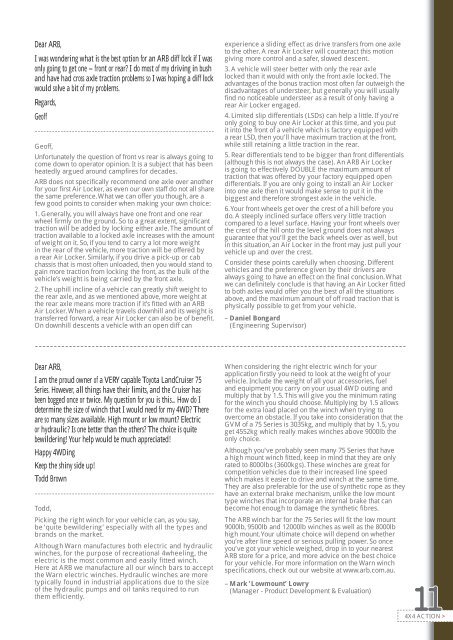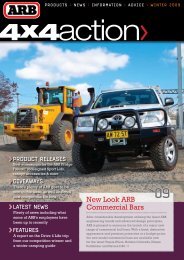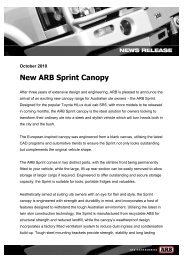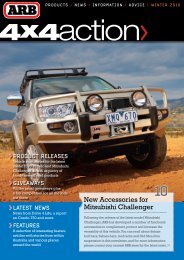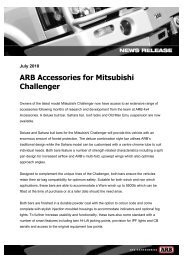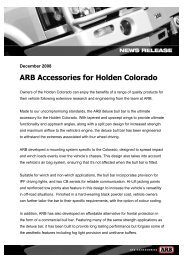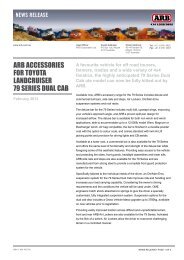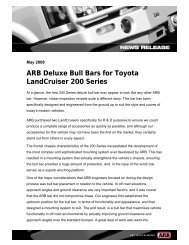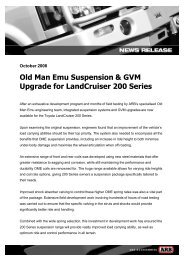Create successful ePaper yourself
Turn your PDF publications into a flip-book with our unique Google optimized e-Paper software.
Dear <strong>ARB</strong>,<br />
I was wondering what is the best option for an <strong>ARB</strong> diff lock if I was<br />
only going to get one – front or rear? I do most of my driving in bush<br />
and have had cross axle traction problems so I was hoping a diff lock<br />
would solve a bit of my problems.<br />
Regards,<br />
Geoff<br />
Geoff,<br />
Unfortunately the question of front vs rear is always going to<br />
come down to operator opinion. It is a subject that has been<br />
heatedly argued around campfires for decades.<br />
<strong>ARB</strong> does not specifically recommend one axle over another<br />
for your first Air Locker, as even our own staff do not all share<br />
the same preference. What we can offer you though, are a<br />
few good points to consider when making your own choice:<br />
1. Generally, you will always have one front and one rear<br />
wheel firmly on the ground. So to a great extent, significant<br />
traction will be added by locking either axle. The amount of<br />
traction available to a locked axle increases with the amount<br />
of weight on it. So, if you tend to carry a lot more weight<br />
in the rear of the vehicle, more traction will be offered by<br />
a rear Air Locker. Similarly, if you drive a pick-up or cab<br />
chassis that is most often unloaded, then you would stand to<br />
gain more traction from locking the front, as the bulk of the<br />
vehicle’s weight is being carried by the front axle.<br />
2. The uphill incline of a vehicle can greatly shift weight to<br />
the rear axle, and as we mentioned above, more weight at<br />
the rear axle means more traction if it’s fitted with an <strong>ARB</strong><br />
Air Locker. When a vehicle travels downhill and its weight is<br />
transferred forward, a rear Air Locker can also be of benefit.<br />
On downhill descents a vehicle with an open diff can<br />
Dear <strong>ARB</strong>,<br />
I am the proud owner of a VERY capable Toyota LandCruiser 75<br />
Series. However, all things have their limits, and the Cruiser has<br />
been bogged once or twice. My question for you is this... How do I<br />
determine the size of winch that I would need for my 4WD? There<br />
are so many sizes available. High mount or low mount? Electric<br />
or hydraulic? Is one better than the others? The choice is quite<br />
bewildering! Your help would be much appreciated!<br />
Happy 4WDing<br />
Keep the shiny side up!<br />
Todd Brown<br />
Todd,<br />
Picking the right winch for your vehicle can, as you say,<br />
be ‘quite bewildering’ especially with all the types and<br />
brands on the market.<br />
Although Warn manufactures both electric and hydraulic<br />
winches, for the purpose of recreational 4wheeling, the<br />
electric is the most common and easily fitted winch.<br />
Here at <strong>ARB</strong> we manufacture all our winch bars to accept<br />
the Warn electric winches. Hydraulic winches are more<br />
typically found in industrial applications due to the size<br />
of the hydraulic pumps and oil tanks required to run<br />
them efficiently.<br />
experience a sliding effect as drive transfers from one axle<br />
to the other. A rear Air Locker will counteract this motion<br />
giving more control and a safer, slowed descent.<br />
3. A vehicle will steer better with only the rear axle<br />
locked than it would with only the front axle locked. The<br />
advantages of the bonus traction most often far outweigh the<br />
disadvantages of understeer, but generally you will usually<br />
find no noticeable understeer as a result of only having a<br />
rear Air Locker engaged.<br />
4. Limited slip differentials (LSDs) can help a little. If you’re<br />
only going to buy one Air Locker at this time, and you put<br />
it into the front of a vehicle which is factory equipped with<br />
a rear LSD, then you’ll have maximum traction at the front,<br />
while still retaining a little traction in the rear.<br />
5. Rear differentials tend to be bigger than front differentials<br />
(although this is not always the case). An <strong>ARB</strong> Air Locker<br />
is going to effectively DOUBLE the maximum amount of<br />
traction that was offered by your factory equipped open<br />
differentials. If you are only going to install an Air Locker<br />
into one axle then it would make sense to put it in the<br />
biggest and therefore strongest axle in the vehicle.<br />
6. Your front wheels get over the crest of a hill before you<br />
do. A steeply inclined surface offers very little traction<br />
compared to a level surface. Having your front wheels over<br />
the crest of the hill onto the level ground does not always<br />
guarantee that you’ll get the back wheels over as well, but<br />
in this situation, an Air Locker in the front may just pull your<br />
vehicle up and over the crest.<br />
Consider these points carefully when choosing. Different<br />
vehicles and the preference given by their drivers are<br />
always going to have an effect on the final conclusion. What<br />
we can definitely conclude is that having an Air Locker fitted<br />
to both axles would offer you the best of all the situations<br />
above, and the maximum amount of off road traction that is<br />
physically possible to get from your vehicle.<br />
– Daniel Bongard<br />
(Engineering Supervisor)<br />
When considering the right electric winch for your<br />
application firstly you need to look at the weight of your<br />
vehicle. Include the weight of all your accessories, fuel<br />
and equipment you carry on your usual 4WD outing and<br />
multiply that by 1.5. This will give you the minimum rating<br />
for the winch you should choose. Multiplying by 1.5 allows<br />
for the extra load placed on the winch when trying to<br />
overcome an obstacle. If you take into consideration that the<br />
GVM of a 75 Series is 3035kg, and multiply that by 1.5, you<br />
get 4552kg which really makes winches above 9000lb the<br />
only choice.<br />
Although you’ve probably seen many 75 Series that have<br />
a high mount winch fitted, keep in mind that they are only<br />
rated to 8000lbs (3600kgs). These winches are great for<br />
competition vehicles due to their increased line speed<br />
which makes it easier to drive and winch at the same time.<br />
They are also preferable for the use of synthetic rope as they<br />
have an external brake mechanism, unlike the low mount<br />
type winches that incorporate an internal brake that can<br />
become hot enough to damage the synthetic fibres.<br />
The <strong>ARB</strong> winch bar for the 75 Series will fit the low mount<br />
9000lb, 9500lb and 12000lb winches as well as the 8000lb<br />
high mount. Your ultimate choice will depend on whether<br />
you’re after line speed or serious pulling power. So once<br />
you’ve got your vehicle weighed, drop in to your nearest<br />
<strong>ARB</strong> store for a price, and more advice on the best choice<br />
for your vehicle. For more information on the Warn winch<br />
specifications, check out our website at www.arb.com.au.<br />
– Mark ‘Lowmount’ Lowry<br />
(Manager - Product Development & Evaluation)<br />
11<br />
4X4 ACTION >


